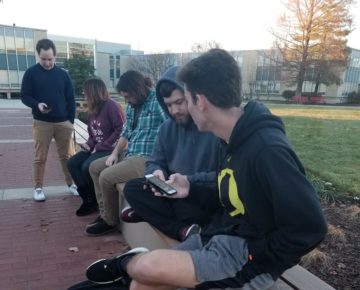The Maryville community who plays “Pokemon Go” has done just that: created an environment where people enjoy going out to battle and catch Pokemon, make new friends and travel to landmarks to earn rewards.

Pokemon Go” is based on the real world map and landmarks in real life. From this, as well as Pokemon spawning at different rates based on real world location, the game has led some players to travel for the game and seeing more of the world than if they were to stay inside playing other games.
The game of Pokemon was originally created in Japan, February 1996. The original trio of games were released for the Nintendo Game Boy, and became very popular in Asia, arriving on scene in the United States in 1998. In the two decades since, dozens of games and TV series have released.
In 2016 Nintendo, along with virtual reality company Niantic, created “Pokemon Go”. “Pokemon Go” is an online mobile game where players can interact with the environment and other ‘trainers’ around them and create a community by adding friends and completing challenges with people in their area.

of “Pokemon Go”. Screenshot courtesy of Eric Cowan.
“I have played ‘Pokemon Go’ since the summer of 2016, so about two and a half years. I play it to pass time when I’m walking to class,” senior Jordyn McCulley said.
“I played it a lot when the game first came out, but took a year break. I started playing again this summer,” sophomore Zachary Suman said.
The story of leaving Pokemon and coming back is a common one. The game has added multiple aspects of the game to retain popularity and has done so successfully. There is a group chat at Maryville that has more than 50 active members, a group larger than some recognized organizations on campus.
Many “Pokemon Go” players enjoy the game because it gives them an opportunity to come back to a game that they spent countless hours playing when they were younger.
“I played Ruby, Emerald and Sapphire when they came out. I got a bunch of games growing up as presents and played all of those too. I like that I can come back to those memories and play now to play on campus,” McCulley said.
On Maryville’s campus, there are 16 Pokestops (landmarks that when visited can give items necessary for traditional gameplay) and 2 ‘gyms (landmarks where your Pokemon can battle to earn coins to buy items in the game’s store).
“Pokemon Go” more recently added raids to the experience, where players can help each other defeat a boss for a chance to catch it. This is the primary use for Maryville’s “Pokemon Go” group chat.
Suman also joined the group chat at Maryville recently, but participated in a raid when he did. “It was cool to see the 10-ish people come out to help each other defeat the raid boss,” Suman said.
Another aspect of the game and reason for the group chat is for comparing catches. Niantic offers events each month and major holiday where new Pokemon are introduced or rarer Pokemon are more common to specific areas. Suman shared that the he played in Washington D.C. and caught some Pokemon that aren’t in Missouri.
If you are considering joining or coming back to the Maryville community, more information about the game can be found at Pokemon Go’s official site.
